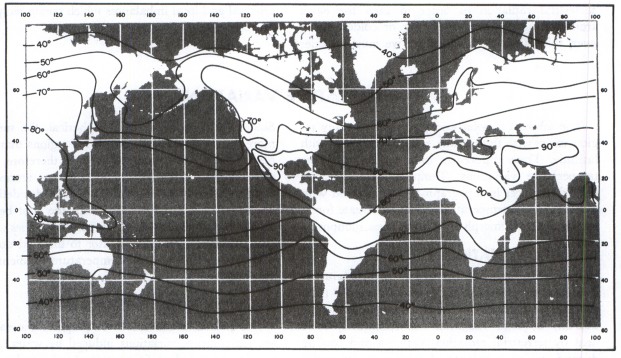Aviation Weather
full text of the classic FAA guide
TEMPERATURE VARIATIONS
The amount of solar energy received by any region varies with time of day, with seasons, and with latitude. These differences in solar energy create temperature variations. Temperatures also vary with differences in topographical surface and with altitude. These temperature variations create forces that drive the atmosphere in its endless motions.
DIURNAL VARIATION
Diurnal variation is the change in temperature from day to night brought about by the daily rotation of the Earth. The Earth receives heat during the day by solar radiation but continually loses heat by terrestrial radiation. Warming and cooling depend on an imbalance of solar and terrestrial radiation. During the day, solar radiation exceeds terrestrial radiation and the surface becomes warmer. At night, solar radiation ceases, but terrestrial radiation continues and cools the surface. Cooling continues after sunrise until solar radiation again exceeds terrestrial radiation. Minimum temperature usually occurs after sunrise, sometimes as much as one hour after. The continued cooling after sunrise is one reason that fog sometimes forms shortly after the sun is above the horizon. We will have more to say about diurnal variation and topographic surfaces.
SEASONAL VARIATION
In addition to its daily rotation, the Earth revolves in a complete orbit around the sun once each year. Since the axis of the Earth tilts to the plane of orbit, the angle of incident solar radiation varies seasonally between hemispheres. The Northern Hemisphere is warmer in June, July, and August because it receives more solar energy than does the Southern Hemisphere. During December, January, and February, the opposite is true; the Southern Hemisphere receives more solar energy and is warmer. Figures 4 and 5 show these seasonal surface temperature variations.


VARIATION WITH LATITUDE
The shape of the Earth causes a geographical variation in the angle of incident solar radiation. Since the Earth is essentially spherical, the sun is more nearly overhead in equatorial regions than at higher latitudes. Equatorial regions, therefore, receive the most radiant energy and are warmest. Slanting rays of the sun at higher latitudes deliver less energy over a given area with the least being received at the poles. Thus, temperature varies with latitude from the warm Equator to the cold poles. You can see this average temperature gradient in figures 4 and 5.
VARIATIONS WITH TOPOGRAPHY
Not related to movement or shape of the earth are temperature variations induced by water and terrain. As stated earlier, water absorbs and radiates energy with less temperature change than does land. Large, deep water bodies tend to minimize temperature changes, while continents favor large changes. Wet soil such as in swamps and marshes is almost as effective as water in suppressing temperature changes. Thick vegetation tends to control temperature changes since it contains some water and also insulates against heat transfer between the ground and the atmosphere. Arid, barren surfaces permit the greatest temperature changes.
These topographical influences are both diurnal and seasonal. For example, the difference between a daily maximum and minimum may be 10° or less over water, near a shore line, or over a swamp or marsh, while a difference of 50° or more is common over rocky or sandy deserts. Figures 4 and 5 show the seasonal topographical variation. Note that in the Northern Hemisphere in July, temperatures are warmer over continents than over oceans; in January they are colder over continents than over oceans. The opposite is true in the Southern Hemisphere, but not as pronounced because of more water surface in the Southern Hemisphere.
To compare land and water effect on seasonal temperature variation, look at northern Asia and at southern California near San Diego. In the deep continental interior of northern Asia, July average temperature is about 50° F; and January average, about −30° F. Seasonal range is about 80° F. Near San Diego, due to the proximity of the Pacific Ocean, July average is about 70° F and January average, 50° F. Seasonal variation is only about 20° F.
Abrupt temperature differences develop along lake and ocean shores. These variations generate pressure differences and local winds which we will study in later chapters. Figure 6 illustrates a possible effect.
Prevailing wind is also a factor in temperature controls. In an area where prevailing winds are from large water bodies, temperature changes are rather small. Most islands enjoy fairly constant temperatures. On the other hand, temperature changes are more pronounced where prevailing wind is from dry, barren regions.
Air transfers heat slowly from the surface upward. Thus, temperature changes aloft are more gradual than at the surface. Let's look at temperature changes with altitude.

VARIATION WITH ALTITUDE
In chapter 1, we learned that temperature normally decreases with increasing altitude throughout the troposphere. This decrease of temperature with altitude is defined as lapse rate. The average decrease of temperature—average lapse rate—in the troposphere is 2° C per 1,000 feet. But since this is an average, the exact value seldom exists. In fact, temperature sometimes increases with height through a layer. An increase in temperature with altitude is defined as an inversion, i.e., lapse rate is inverted.
An inversion often develops near the ground on clear, cool nights when wind is light. The ground radiates and cools much faster than the overlying air. Air in contact with the ground becomes cold while the temperature a few hundred feet above changes very little. Thus, temperature increases with height. Inversions may also occur at any altitude when conditions are favorable. For example, a current of warm air aloft overrunning cold air near the surface produces an inversion aloft. Figure 7 diagrams temperature inversions both surface and aloft. Inversions are common in the stratosphere.

Table of Contents
Previous Section: Heat and Temperature
Next Section: In Closing
A PDF version of this book is available here. You may be able to buy a printed copy of the book from amazon.com.
